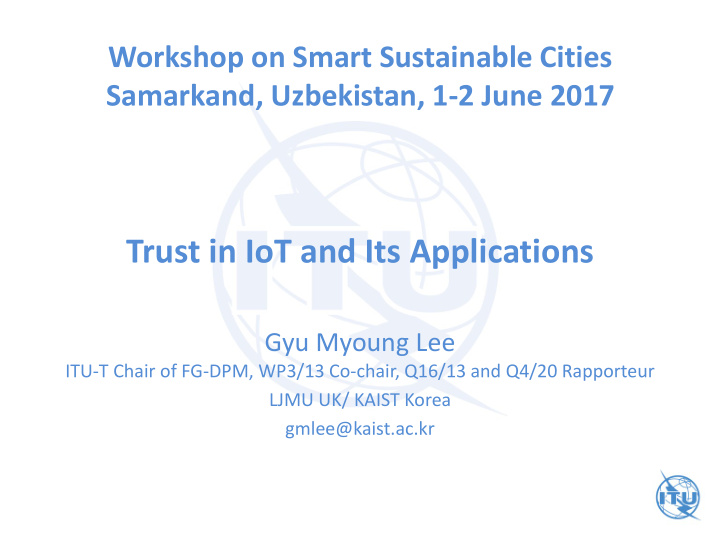



Workshop on Smart Sustainable Cities Samarkand, Uzbekistan, 1-2 June 2017 Trust in IoT and Its Applications Gyu Myoung Lee ITU-T Chair of FG-DPM, WP3/13 Co-chair, Q16/13 and Q4/20 Rapporteur LJMU UK/ KAIST Korea gmlee@kaist.ac.kr
Contents • Introduction – Trust in IoT • Understanding of Trust – Trust features • Key Design Principles and Challenges • Various Technical Issues • Use case, emerging technology • Conclusion 2
Trust and Knowledge • Future trust and knowledge infrastructure ICT is a Basis of Knowledge Society Y.3052 – “Overview of trust Potential Risks provisioning in ICT infrastructures and services” Feb. 2017 3
Increasing Intelligence in IoT Control and Trust • Behave intelligently and rationally to – Sense real-world behaviour – Perceive the world using information models – Adapt to different environments and changes – Learn and build knowledge – Act to control their environments 4
Barrier to growth of IoT market Data and Trust Volume – Data at Rest Variety – Data in Many Forms Velocity – Data in Motion Variability – Data in Change Source: 2014 Internet of Things Privacy Infographic Veracity – Data in Doubt 5
Towards Internet of Value Data is Value – How to measure Value? Source: i-SCOOP, https://www.i-scoop.eu/internet-of-things-guide/internet-of-things/ 6
Security, Privacy and Trust IoPTS – Internet of People, Things & Services NIST - CPS Framework Industrial Internet of Things 7
Understanding of Trust Trust of a party A to a party B for a given task S is the measurable belief of A in that B accomplishes S dependably for a specified period P within a particular trust context T (in relation to the task S ) Trust is relative to a specific task (a service). Different trust relationships appear in different business contexts The measurement may be absolute (e.g. probability) or relative (e.g. Level of Trust) This period may be in the past (history), the duration of the service (from now and until end of service), future (a scheduled or forecasted critical time slot), or always Dependability is deliberately understood broadly to include availability, reliability, safety, confidentiality, integrity and serviceability 8
Social Cyber Physical Trust Social world Trusted ICT applications Social Social Trust Trust Social Entities Cyber world ICT infrastructures and services Everything as a Service Everything as a Service E-commerce Cyber Cyber Healthcare Trust Trust Cyber Objects Communication Communication Social media Control Control Computing Computing Physical world Physical Things Intelligent Environment Physical Physical transportation Trust Trust 9
Direct Trust vs. Indirect Trust 10
Computational Trust Direct Observation ICT (Knowledge) Social Trust T R Reputation Experience Computational Trust Computational Trust U Third Party Personal (Trust Data Management (Trust Data Management Information S Observation – DIKW Process) – DIKW Process) T System Dependability Direct Observation (Knowledge) 11
Key Design Principles Consider Trust as a Key Component for IoT • Interactions and relationships among Social/Cyber/Physical worlds • Ensuring IoT data quality • Trustable intelligent services based on data convergence and mining • Trustworthy environment for correct operations • Enhanced security and privacy 12
Challenges for Trust in general 1. Understanding of trust 7. Constraint 2. Trust relationships environment 3. Trust management 8. T-SCPI architecture 4. Measure & calculate 9. New business models 5. Decision making 10.Standardization 6. Autonomy NOTE - T-SCPI: Trustworthy Social-Cyber-Physical Infrastructure Gyu Myoung Lee, “Challenges for Trustworthy Social -Cyber- Physical Infrastructure,” ITU Workshop on “Future Trust and Knowledge Infrastructure”, Phase 1, Apr. 2015. 13
Challenges for Trust in IoT • Highly interconnected IoT infrastructure – A new kind of complex system • Assuring continuous trustworthiness – Trust is situation-specific and trust changes over time • Data transparency – Promote transparency about what data is collected and how it will be processed and handled • Trust, security and privacy become tightly coupled – A unified approach towards trust, security and privacy co- analysis, design, implementation and verification • The integration of the physical, cyber, and social worlds – Social-cyber-physical trust relationships 14
Technical Issues • Identification of entities • Trustworthy data collection and aggregation • Trustworthy data process and analysis • Trust modelling and measuring • Trust computation and trust evaluation/validation • Dissemination of trust information • Trust establishment and provisioning • Trustworthy system lifecycle management 15
Trust Relationship Model 16
Trust Computation Procedure V A L U E 17
Trust Index 18
Trustworthy Smart City Crowdsensing Smart Citizen – collective monitoring of the city • Smart transportation, smart metering and public safety – Benefits to public, business and government – Ensuring Trustworthiness MCS: Mobile CrowdSensing 19
A New Paradigm – Blockchain “It is a machine for creating trust.” (Source: The Economist) • The currency in the IoT is data . • Revolutionizes how transactions are recorded – a decentralized digital ledger that records transactions – building trust , reducing costs and accelerating transactions Value- Value- Value- Value- Crypto- Crypto- Value-Web Value-Web currencies currencies Registry Registry Ecosystem Ecosystem 20
Conclusion “ Trust is the oxygen which will breathe life into the IoT. Industry needs to show data is safe and that it is properly treated.” (source: www.techuk.org.) Trust is an essential element for value added business models in the IoT. 21
Recommend
More recommend